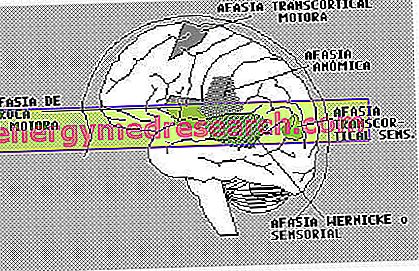Generality
A sarcoma is a malignant tumor that originates from a cell of a soft tissue, a cell of a bone tissue or a cell of cartilaginous tissue.

There are numerous types of sarcoma; the most famous types are: angiosarcoma, fibrosarcoma, leiomyosarcoma, liposarcoma, rhabdomyosarcoma, gastrointestinal stromal tumor and Kaposi's sarcoma.
Very often, an early sarcoma is asymptomatic; in fact, it begins to induce the first symptoms when the tumor mass assumes considerable dimensions, and this occurs only at an advanced stage.
Possible treatments of a sarcoma include surgery, radiotherapy and chemotherapy.
Short review of what a tumor is
In medicine, the term tumor identifies a mass of very active cells, able to divide and grow uncontrollably.
- We speak of a benign tumor when the growth of cell mass is not infiltrative (that is, it does not invade the surrounding tissues) and even metastasizing.
- There is talk of a malignant tumor when the abnormal cell mass has the ability to grow very quickly and to spread to the surrounding tissues and the rest of the body.
The terms malignant tumor, cancer and malignant neoplasia are to be considered synonymous.
What is a sarcoma?
A sarcoma is any malignant tumor that originates from a soft tissue cell, a bone tissue cell or a cartilaginous tissue cell.
In this article, the attentions will be mainly directed to the sarcomas that derive from the soft tissues, which are better known as soft-tissue sarcomas .
Bone sarcoma
Sarcomas originating from bone or cartilage tissue are called bone sarcomas .
WHAT ARE THE SOFT FABRICS?
In histology, they are included in the list of soft tissues: adipose tissue, muscles, tendons, ligaments, blood vessels, lymphatic vessels, hematopoietic cells and nerves.
LOCATIONS
Any district of the human body may develop sarcoma. However, there are more affected sites than others, such as legs, arms, trunk and abdomen.
Poorly affected districts of the human body are the neck and the head.
EPIDEMIOLOGY OF THE SOFT TISSUE SARCOMA
According to some statistical surveys, around 60% of sarcoma cases have an arm or a leg from the tumor site; about 30% have the trunk or abdomen as the site of origin of the malignant neoplasm; finally, about 10% of their neck or head has a tumor site.
People of any age can develop sarcoma; older people, however, are the most affected subjects.
In general, sarcoma is an uncommon type of cancer in the general population.
- Sarcomas represent about 1% of all malignant tumors affecting adults;
- Sarcomas represent 10-15% of all malignant tumors affecting children;
- In the UK, doctors diagnose sarcoma every 100 cases of malignancy;
- Still in the United Kingdom, there are more than 3, 000 cases of sarcoma per year;
- In the United States, there are about 15, 000 cases of sarcoma per year;
- In Italy, according to data from the Cancer Registries for 2012, the number of sarcoma annual cases would have been around 1, 900 (1, 100 men and 800 women).
Causes
The human body contains just over 37 trillion cells . These cells have a life cycle, which involves phases of growth, division and death.
The entire life cycle of a generic cell in the human body depends on its genetic heritage, contained in the cellular nucleus and known as DNA . DNA is a highly efficient and precise machine, capable of accurately directing and controlling the phases of growth, division and death.
A sarcoma arises following a series of irreparable damage ( mutations ) to the DNA; damage that prevents the DNA itself from accurately and accurately regulating cellular growth, division and cell death processes.
From all this it follows that the cell or cells involved in the mutational events of the genetic heritage grow and divide uncontrollably (there is also talk of uncontrolled cell proliferation ).
The cells of a sarcoma - but in reality all the cells of a generic malignant neoplasm - also take the name of " cells gone mad ": this wording indicates precisely the anomaly that distinguishes them and the particular lack of control of growth processes and division.
RISK FACTORS
Doctors have not yet accurately identified the causes of sarcoma; however, they noted that some particular circumstances represent an important risk factor.
Among the main and proven factors favoring the appearance of a sarcoma, are:
- Advanced age. It is a fact that the onset of a sarcoma is more frequent in elderly people. According to a reliable statistical survey, about 40% of soft tissue sarcoma diagnoses would have as subjects protagonists aged 65 and over;
- A past history of exposure to ionizing radiation. It may be an environmental exposure (eg: nuclear disasters) or a subsequent exposure to a radiotherapy cycle (eg: people with a tumor who have had to undergo radiotherapy treatment);
- Exposure, in past times, to chemical substances such as vinyl chloride, dioxins or chlorophenols;
- The presence of certain genetic conditions, including neurofibromatosis, retinoblastoma and Li Fraumeni syndrome.
- The presence of some infectious diseases and / or an inefficient immune system. Among the infectious diseases that predispose to sarcomas, they deserve a mention: infections caused by human Herpes virus 8, HIV (or AIDS) and infections caused by Epstein Barr virus.
Other likely risk factors:
- Obesity;
- Presence of an inguinal or umbilical hernia;
- Cigarette smoke.
Types
There are numerous types of soft tissue sarcoma.
The most important and widespread types include:
- Angiosarcoma . It is a type of sarcoma that originates from a cell of a blood vessel or lymphatic vessel.
According to an Anglo-Saxon statistics survey, in the United Kingdom, about 145 new cases of angiosarcoma are recorded every year;
- Fibrosarcoma . It is a type of sarcoma that originates from fibroblasts. Fibroblasts are the most common cellular elements in connective tissues. It can develop in any district of the human body.
According to an Anglo-Saxon statistics survey, in the United Kingdom, approximately 460 new cases of fibrosarcoma are recorded each year;
- Leiomyosarcoma . It is a type of sarcoma that develops from a smooth muscle cell.
According to an Anglo-Saxon statistics survey, in the United Kingdom, about 660 new cases of leiomyosarcoma are recorded every year;
- Liposarcoma . It is a type of sarcoma that originates from a cell of adipose tissue.
According to an Anglo-Saxon statistical survey, in the United Kingdom, about 440 new cases of liposarcoma are recorded each year;
- Rhabdomyosarcoma . It is a type of sarcoma that originates in a cell of skeletal muscle tissue. It can be formed in any district of the human body.
There are two sub-forms of rhabdomyosarcoma: embryonic rhabdomyosarcoma and alveolar rhabdomyosarcoma. The first is more common in children and young adults; the second, on the other hand, is more frequent in adults.
According to an Anglo-Saxon statistics survey, in the United Kingdom, about 120 new cases of rhabdomyosarcoma are recorded every year;
- Gastrointestinal stromal tumor . It is a type of sarcoma that originates from a neuromuscular cell of the digestive system;
- Kaposi's sarcoma . It is a type of sarcoma that develops from an endothelial cell of the skin, viscera or mucous membranes.
Types of sarcoma less known | Origin |
Alveolar soft tissue sarcoma | unknown |
Desmoid fibromatosis | Fibroblasts |
neurofibrosarcoma | Cells that surround nerve endings (eg, Schwann cells) |
Myxofibrosarcoma | Connective tissue |
Synovial sarcoma | Near the ligaments and tendons, which are part of synovial joints such as, for example, the knee |
Undifferentiated pleomorphic sarcoma | Fibroblasts. It is a particular subtype of fibrosarcoma |
Types of Bone Sarcoma
There are also various types of bone sarcoma .
The list of the main types of bone sarcoma includes: osteosarcoma, chondrosarcoma, Ewing's sarcoma, chordoma and sarcoma of post cells.
Symptoms, signs and complications
Generally, when a sarcoma is in its infancy, the mass of tumor cells that characterizes it is small and does not cause any noteworthy disturbance; in other words, therefore, sarcomas in the early stages do not cause any particular symptoms or signs.
Over time, the tumor mass progressively increases its size, becoming more and more bulky and bulky, especially for the neighboring anatomical structures.
All this is usually reflected in the appearance of a protuberance - clearly where sarcoma resides - and in the presence of a rather intense painful sensation.
OTHER SYMPTOMS: WHAT DO THEY DEPEND ON?
In the case of sarcoma, the presence of other symptoms and signs, in addition to the protuberance and pain, depends on the type of tissue from which the tumor originates, and on the anatomical location (always of the tumor).
Some examples:
- A gastrointestinal stromal tumor usually causes a feeling of fullness in the stomach and constipation;
- A leiomyosarcoma located in the uterus causes vaginal bleeding.
FEATURES OF A HIGHLY SUSPECTED PROTUBERANCE
In general, the protuberances that identify the presence of a sarcoma are:
- Large (more than 5 centimeters) and with a tendency to increase their size;
- Located in the deepest tissues;
- Painful.
Furthermore, another highly suspicious feature is the fact that the person concerned is an elder.
COMPLICATIONS
An advanced stage sarcoma is a malignant tumor capable of spreading its cancer cells to organs and tissues distant from the place of origin.
The cells that a tumor disperses in other anatomical districts of the body are called metastases .
Returning to the sarcomas, the anatomical sites most affected by metastases are the lungs and the liver.
Diagnosis
According to the most recent guidelines (of the National Institute for Health and Care Excellence ), a correct diagnosis of sarcoma would be based on: physical examination, medical history, a series of diagnostic imaging tests and tumor biopsy.
An accurate diagnosis of sarcoma allows doctors to establish the most appropriate treatment for the case.
OBJECTIVE AND ANAMNESIS EXAMINATION
The physical examination is the set of diagnostic maneuvers, carried out by the doctor, to verify the presence or absence, in the patient, of signs indicative of an abnormal condition.
- In case of suspected sarcoma, one of the most common diagnostic maneuvers consists in touching the protuberance and assessing its consistency and pain.
The anamnesis, on the other hand, is the collection and critical study of symptoms and facts of medical interest, reported by the patient or his family members (NB: family members are involved, above all, when the patient is small).
- In case of suspected sarcoma, a past event of exposure to ionizing radiation is a matter of great medical interest.
DIAGNOSTICS FOR IMAGES
The most widely used diagnostic imaging test in the presence of a suspected sarcoma is nuclear magnetic resonance (NMR).
Painless test, the nuclear magnetic resonance allows to visualize, through an instrument that creates magnetic fields, the internal structures of the human body, in particular those made up of soft tissues.
MRI is a very useful diagnostic test to identify the precise site and size of a sarcoma.
Typically, a classical nuclear magnetic resonance lasts about 30-40 minutes.
Other diagnostic imaging tests, which could be useful in some way, are the CT scan (or computerized axial tomography) and the PET.
TUMOR BIOPSY
A tumor biopsy consists in the collection and in the histological analysis, in the laboratory, of a sample of cells coming from the tumor mass, constituting the sarcoma.
It is the most suitable test to define the main characteristics of sarcomas, from histology to cells of origin, passing through the degree of malignancy, staging, etc.
Performed under local or general anesthesia, the taking of cells from a sarcoma can occur in at least two different ways: by means of a needle or by means of a scalpel.
- Needle tumor biopsy (or tumor needle biopsy ). This practice could lead to the collection of a small sample of cells. Laboratory analysis on a small number of cells has a tendency to be unreliable.
If the tumor mass resides very deeply, the doctor will practice the needle biopsy being guided by the images coming from an ultrasound scan or a CT scan;
- Scalpel tumor biopsy ( surgical tumor biopsy ). This practice is very effective and the sample of cancer cells collected is, in almost all cases, reliable.
What are staging and the degree of a malignant tumor?
The staging of a malignant tumor includes all that information, collected during biopsy, which concerns the size of the tumor mass, its infiltrating power and its metastasizing capacities. There are 4 main stages of staging (or stages): stage 1 is the least severe, stage 4 is the most severe.
The degree of a malignant tumor, on the other hand, includes all those data that emerged during the biopsy, which concern the extent of transformation of malignant tumor cells, compared to their healthy counterparts. There are 4 main degrees of increasing severity: therefore, grade 1 is the least severe, while grade 4 is the most severe.
Therapy
The choice of which treatment to adopt in case of sarcoma depends on various factors, including: staging and degree of malignant tumor (presence of metastases, progression of the disease, etc.), the histological type of sarcoma, the general state of health of the patient, the age of the patient and the affected areas of the body.
Currently, the possible treatments of a sarcoma are: surgery to remove the tumor mass, radiotherapy and chemotherapy.
SURGERY
Surgery to remove the tumor mass is the main treatment in most cases of sarcoma.
In practicing surgical removal, doctors always work with the intent to eliminate the entire tumor, but they do not always succeed or do not always have the chance. In fact, if the tumor mass is located in an uncomfortable point or is very large, the complete removal of the sarcoma could be impossible.
An important side effect of surgery on sarcomas consists in the fact that the removal of the tumor involves the alteration of the normal anatomy of the anatomical district concerned. For example, the removal of a rhabdomyosarcoma causes, at the end of the surgical procedure, a more or less substantial portion of muscle tissue to be missed.
Today, more than once, there are countermeasures to this side effect: these countermeasures consist of plastic surgery, for the reconstruction of the altered anatomical district.
When a sarcoma is particularly severe and resides on a limb, surgery may involve amputation of the affected limb. Fortunately, surgical amputation is an increasingly less practiced solution, as medical surgery is making steady progress.
RADIOTHERAPY
Radiation therapy involves exposing the tumor mass to a certain dose of high-energy ionizing radiation (X-rays), which are intended to destroy neoplastic cells.
In the case of sarcoma, radiotherapy can represent:
- An alternative to surgery, if this is not practicable. Sometimes, in such situations, it can be associated with radiotherapy;
- A post-surgical treatment, carried out with the aim of destroying the cancer cells that the operating doctor was unable to remove. In these situations we also speak of adjuvant radiotherapy ;
- A pre-surgical treatment, carried out with the aim of facilitating the subsequent removal of the tumor mass. In such circumstances, there is also talk of neoadjuvant radiotherapy .
The typical side effects of radiotherapy are: skin irritation, sense of tiredness and hair loss at the level of exposure to ionizing radiation.
Radiotherapy is NOT necessary after surgery, if:- Sarcoma is low grade;
- The sarcoma is small;
- Sarcoma is superficial or, in any case, it is not in the deeper tissues.
CHEMOTHERAPY
Chemotherapy consists of the administration of drugs capable of killing rapidly growing cells, including cancer ones.
In the case of sarcoma, chemotherapy may represent:
- An alternative to surgery, if this is not practicable. Sometimes, in such situations, it can be associated with radiotherapy;
- A pre-operative treatment, carried out with the intention of facilitating the subsequent removal of the tumor mass. In such circumstances, one also speaks of neoadjuvant chemotherapy .
The classic side effects of chemotherapy consist of: recurrent tiredness, a sense of weakness, malaise and hair loss in different areas of the body.
Prognosis
In general, the prognosis in the case of sarcoma depends on staging and degree: the higher the staging and the greater the degree, the lower the chances of recovery; conversely, stage 1 and low grade sarcomas present good chances of cure.
In light of this, early diagnosis is essential, as this allows the tumor to be treated when it is still in its infancy (ie in the early stages).
According to an Anglo-Saxon statistic, concerning the United Kingdom, the average survival rate 5 years after the diagnosis of a sarcoma is equal to about 60%; in other words, about 60 subjects with sarcoma out of 100 are still alive after 5 years from tumor identification and removal.
Statistics from the United States relating to sarcomas, which affect the upper and lower limbs. The table shows the survival rate based on the tumor stage.
- Sarcoma in stage 1: 90 individuals treated out of 100 are still alive 5 years after diagnosis;
- Stage 2 sarcoma: 80 subjects treated out of 100 are still alive 5 years after diagnosis;
- Stage 3 sarcoma: 60 subjects treated per 100 are still alive 5 years after diagnosis;
- Sarcoma in stage 4: there is no precise data on this, but surely the survivors, after 5 years from the diagnosis of sarcoma, are many less than 60%.



